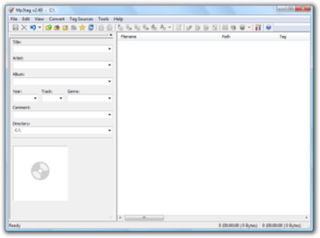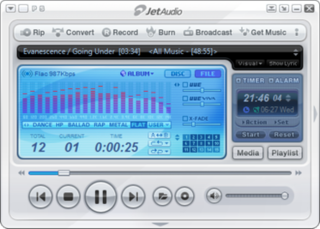
Vorbis is a free and open-source software project headed by the Xiph.Org Foundation. The project produces an audio coding format and software reference encoder/decoder (codec) for lossy audio compression, libvorbis. Vorbis is most commonly used in conjunction with the Ogg container format and it is therefore often referred to as Ogg Vorbis.

Windows Media Player, is the first media player and media library application that Microsoft developed to play audio and video on personal computers. It has been a component of the Microsoft Windows operating system, including Windows 9x, Windows NT, Pocket PC, and Windows Mobile. Microsoft also released editions of Windows Media Player for classic Mac OS, Mac OS X, and Solaris, but has since discontinued them.
Xiph.Org Foundation is a nonprofit organization that produces free multimedia formats and software tools. It focuses on the Ogg family of formats, the most successful of which has been Vorbis, an open and freely licensed audio format and codec designed to compete with the patented WMA, MP3 and AAC. As of 2013, development work was focused on Daala, an open and patent-free video format and codec designed to compete with VP9 and the patented High Efficiency Video Coding.
The Advanced Stream Redirector (ASX) format is a type of XML metafile designed to store a playlist of Windows Media files for a multimedia presentation.

A playlist is a list of video or audio files that can be played back on a media player, either sequentially or in a shuffled order. In its most general form, an audio playlist is simply a list of songs that can be played once or in a loop. The term has several specialized meanings in the realms of television broadcasting, radio broadcasting and personal computers.
M3U is a computer file format for a multimedia playlist. One common use of the M3U file format is creating a single-entry playlist file pointing to a stream on the Internet. The created file provides easy access to that stream and is often used in downloads from a website, for emailing, and for listening to Internet radio.
PLS is a computer file format for a multimedia playlist. It is typically used by media players for streaming media over the Internet, but may also be used for playing local media.

JRiver Media Center is a multimedia application that allows the user to play and organize various types of media on a computer running Windows, macOS, or Linux operating systems. Developed by JRiver, Inc., it is offered as shareware.

WinPlay3 was the first real-time MP3 audio player for PCs running Windows, both 16-bit and 32-bit. Prior to this, audio compressed with MP3 had to be decompressed prior to listening. It was released by Fraunhofer IIS, creators of the MP3 format, on September 9, 1995. The latest version was released on May 23, 1997. Since then, the Fraunhofer Society has removed any trace and mention of WinPlay3 from their web sites. However, the software remains available by utilizing the Web Archive, or one of the links below.
Webjay was a web-based playlist service launched in early 2004. Playlists consisted of links to Vorbis, MP3, WMA, RealAudio and/or other audio files on the web. Webjay users could create new playlists by copying from existing playlists, or by web scraping audio file links from external web pages or playlists. The site was created by Lucas Gonze.
WPL is a computer file format that stores multimedia playlists. It is a proprietary file format used in Microsoft Windows Media Player versions 9–12. The elements of WPL files are represented in XML format. The top-level element, smil, specifies that the file's elements follow the SMIL structure.

Netgear's Digital Entertainer line of products are digital media players that can pull multimedia content from home computers to the typical audio/video entertainment center. There are three products in the line, the EVA700, the HD EVA8000 and the current EVA9150 Digital Entertainer Elite. All support high definition video, the EVA700 via component output up to 1080i and the EVA8000/EVA9000 up to 1080p with both component and HDMI connectors. All models support audio, video, image and streaming audio and video formats and can be networked via wired and wireless Ethernet. The EVA700 is Intel Viiv certified.

Mp3tag is a metadata tag editor that supports many popular audio file formats. It is freeware for Microsoft Windows, while it costs USD $19.99 for Apple macOS in the Mac App Store.
A playlist markup language is a markup language that specifies the contents and playback of a digital multimedia playlist; this includes streams of music, slideshows or even animations.
The following comparison of audio players compares general and technical information for a number of software media player programs. For the purpose of this comparison, "audio players" are defined as any media player explicitly designed to play audio files, with limited or no support for video playback. Multi-media players designed for video playback, which can also play music, are included under comparison of video player software.

JetAudio is a shareware media player application for Microsoft Windows and Android released in 1997, that offers playback options for a wide range of multimedia file formats.

MusicBee is a freeware media player for playback and organization of audio files on Microsoft Windows, built using the BASS audio library.

Clementine is a free and open-source audio player. It is a port of Amarok 1.4 to the Qt 4 framework and the GStreamer multimedia framework. It is available for Unix-like, Windows, and macOS operating systems. Clementine is released under the terms of the GPL-3.0-or-later.

GNOME Videos, formerly known as Totem, is a media player for the GNOME computer desktop environment. GNOME Videos uses the Clutter and GTK+ toolkits. It is officially included in GNOME starting from version 2.10, but de facto it was already included in most GNOME environments. Totem utilizes the GStreamer framework for playback, though until version 2.27.1, it could alternatively be configured to use the Xine libraries instead of GStreamer.

Quod Libet is a cross-platform free and open-source audio player, tag editor and library organizer. The main design philosophy is that the user knows how they want to organize their music best; the software is therefore built to be fully customizable and extensible using regular expressions and boolean logic. Quod Libet is based on GTK and written in Python, and uses the Mutagen tagging library.










